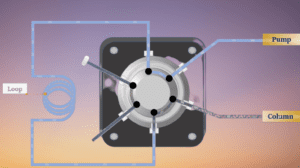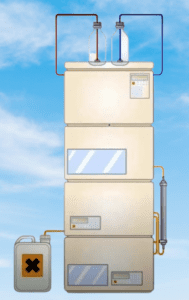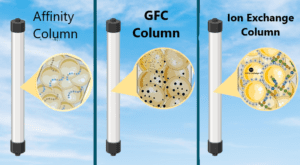HPLC (High-performance liquid chromatography) is used to separate, recognize, and measure components in mixtures. It is a type of chromatography that uses a liquid mobile phase to move a sample mixture through a column packed with a stationary phase. Hplc is a very important and common instrument of the Quality Control Lab. In this topic, we briefly understand the hplc principle it’s working, uses, and importance in pharma organizations. The sample is introduced into the mobile phase and moves through the column, where it interacts with the stationary phase. The components in the sample mixture interact differently with the stationary phase, causing them to be separated and eluted from the column at different times. HPLC is widely used in a variety of fields, including pharmaceuticals, biotechnology, food analysis, environmental monitoring, and forensic science. It can be used to separate and quantify small molecules, such as drugs, amino acids, and pesticides, as well as large molecules, such as proteins and nucleic acids.
Principle of hplc (High-Performance Liquid Chromatography)
The principle of hplc (High-Performance Liquid Chromatography) is based on the separation of components in a mixture through the interaction of the sample with the stationary phase and the mobile phase. In HPLC, the sample is introduced into a column containing a stationary phase, which is typically a solid or gel-like material. The mobile phase, which is a liquid or a gas, is passed through the column at high pressure to move the sample through the stationary phase. The components in the sample mixture interact differently with the stationary phase based on their physical and chemical properties, such as size, polarity, and charge. This results in different retention times for each component, meaning each component will be eluted from the column at a different time. A detector is used to monitor the eluted components and produce a chromatogram, which is a graph showing the signal intensity of each component over time. The identity and quantity of each component can be determined by comparing the retention times and signal intensities to those of known standards or reference materials. Overall, the principle of HPLC is based on the selective interaction of the sample with the stationary and mobile phases, which allows for the separation, identification, and quantification of components in a mixture.


hplc and its instrumentation:
The HPLC instrument consists of several components, including a pump that delivers the mobile phase through the column, a sample injector that introduces the sample into the mobile phase, a column that contains the stationary phase, a detector that monitors the eluted sample components, and a data processing unit that records and analyzes the output of the detector.
The mobile phase is pumped through the column at a constant flow rate, and the sample components interact with the stationary phase based on their size, polarity, and other physicochemical properties. As the components elute from the column, they are detected by the detector, which produces a chromatogram that represents the separation of the sample components based on their retention times and peak areas.
The choice of the stationary phase, mobile phase, and detector depend on the nature of the sample and the analytical requirements. HPLC can be used to analyze a wide range of compounds, including small molecules, proteins, peptides, and nucleic acids, making it a versatile and widely used analytical technique in various fields of research and industry.
Major Components of the hplc (High-Performance Liquid Chromatography)
The major components of a High-Performance Liquid Chromatography (HPLC) system include:
- Pump: The pump is used to deliver the mobile phase at a constant flow rate through the stationary phase in the column.
- Injector: The injector is used to introduce the sample into the mobile phase. The sample can be injected manually or automatically.
- Column: The column contains the stationary phase, which is typically a solid material that interacts with the sample components based on their physicochemical properties.
- Detector: The detector monitors the eluent from the column and produces a signal that is proportional to the concentration of the eluted components.
- Data processing unit: The data processing unit records and analyzes the output of the detector, and produces a chromatogram that represents the separation of the sample components.
- Mobile phase: The mobile phase is a liquid or a mixture of liquids that flow through the column and elutes the sample components.
- Stationary phase: The stationary phase is a solid material that is packed in the column and interacts with the sample components based on their size, polarity, and other physicochemical properties.
These components work together to separate and analyze complex mixtures of compounds in various fields of research and industry, including pharmaceuticals, biotechnology, food and beverage, environmental analysis, and forensic science.

Different Types of HPLC
There are several types of High-Performance Liquid Chromatography (HPLC), each with different column types, mobile phases, and detection methods. The most common types of HPLC include:
1. Reverse Phase Chromatography (RPC): In RPC, the stationary phase is non-polar and the mobile phase is polar. It is used for separating and quantifying hydrophobic compounds such as proteins, peptides, and drugs.
2. Normal Phase Chromatography (NPC): In NPC, the stationary phase is polar and the mobile phase is non-polar. It is used for separating and quantifying hydrophilic compounds such as polar solvents, inorganic ions, and carbohydrates.
3. Ion Exchange Chromatography (IEC): In IEC, the stationary phase is charged and the mobile phase contains ions with the opposite charge. It is used for separating and quantifying charged molecules such as proteins, peptides, and amino acids.
4. Size Exclusion Chromatography (SEC): In SEC, the stationary phase contains porous beads of varying sizes, and the mobile phase moves through the beads by filtration. It is used for separating and quantifying molecules based on their size, such as proteins, polysaccharides, and polymers.
5. Affinity Chromatography (AC): In AC, the stationary phase contains ligands that selectively bind to the target molecule, while the mobile phase elutes the unbound molecules. It is used for purifying and quantifying proteins, antibodies, and other biomolecules.
6. Chiral Chromatography (CC): In CC, the stationary phase contains chiral compounds, and the mobile phase moves through the column with the sample. It is used for separating enantiomers of chiral compounds such as amino acids, sugars, and drugs.
Each type of HPLC is optimized for specific types of compounds and applications, and the choice of the HPLC method depends on the properties of the sample and the analytical requirements.
HPLC Stationary Phase and Mobile Phase
The stationary and mobile phases are two key components of High-Performance Liquid Chromatography (HPLC). The mobile phase is a liquid or a gas that is used to transport the sample through the stationary phase, which is a solid or gel-like substance that is packed into a column.
The stationary phase in HPLC can be made from a variety of materials, such as silica, alumina, or polymers. The surface of the stationary phase is modified with various chemical groups, such as C18, C8, phenyl, amino, or ion-exchange groups, to interact with the sample selectively. The choice of the stationary phase depends on the properties of the sample and the separation method used. The mobile phase in HPLC is typically a mixture of solvents, such as water, acetonitrile, methanol, or tetrahydrofuran, that is optimized for the separation of the sample. The mobile phase is delivered to the column by a pump, and the flow rate is carefully controlled to optimize the separation. The choice of the mobile phase depends on the properties of the sample and the separation method used. Overall, the stationary phase and mobile phase are carefully chosen to optimize the separation of the sample, and the choice of these components depends on the properties of the sample and the analytical requirements.
High-Performance Liquid Chromatography Work?
High-Performance Liquid Chromatography (HPLC) works by separating and quantifying components in a mixture based on their interactions with the stationary and mobile phases in a column. The process of HPLC can be broken down into several steps:
- Injection of the Sample: The sample is introduced into the mobile phase, typically by injection into the sample loop of the HPLC instrument.
- Mobile Phase Delivery: The mobile phase, which is a solvent or a mixture of solvents, is pumped through the column at a constant flow rate. The mobile phase carries the sample through the column, where it interacts with the stationary phase.

- Separation of Components: As the sample moves through the column, each component interacts differently with the stationary phase based on its size, polarity, and other properties. This results in differential retention times for each component, with each component eluting from the column at a different time.
- Detection and Quantification: A detector, such as a UV-Vis spectrophotometer or a mass spectrometer, is used to monitor the eluted components and produce a chromatogram, which is a graph showing the signal intensity of each component over time. The identity and quantity of each component can be determined by comparing the retention times and signal intensities to those of known standards or reference materials.
The choice of the stationary phase, mobile phase, and detection method depend on the properties of the sample and the analytical requirements. Overall, HPLC is a powerful analytical technique that can be used to separate and quantify a wide range of compounds in a mixture. The organization has an Hplc Column Storage Cabinet.

Uses of hplc
High-Performance Liquid Chromatography (HPLC) is a widely used analytical technique in various fields, including pharmaceuticals, biotechnology, food and beverage, environmental analysis, and forensic science. Some of the common uses of HPLC are:
- Analysis of Pharmaceuticals: HPLC is used to analyze the purity, potency, and stability of drugs, as well as to detect impurities and degradation products. HPLC is also used to quantify drug compounds in biological samples such as blood, plasma, and urine.
- Separation of Proteins and Peptides: HPLC is used to separate and purify proteins and peptides, as well as to quantify their concentrations in biological samples. Reverse Phase Chromatography (RPC) and Size Exclusion Chromatography (SEC) are commonly used for this purpose.
- Food and Beverage Analysis: HPLC is used to analyze food and beverage samples for additives, preservatives, and contaminants. HPLC can also be used to quantify vitamins, amino acids, and other nutrients in food products.
- Environmental Analysis: HPLC is used to analyze environmental samples for pollutants, such as pesticides, herbicides, and heavy metals. HPLC can also be used to analyze water samples for contaminants and to quantify pollutants in air samples.
- Forensic Science: HPLC is used to analyze biological samples, such as blood, urine, and tissue samples, for drugs of abuse and other compounds. HPLC can also be used to analyze forensic evidence such as fibers, paint, and explosives.
Overall, HPLC is a versatile analytical technique that can be used to separate, purify, and quantify a wide range of compounds in various fields of research and industry.
Bullet points of hplc working & functionalities.
- High Performance Liquid Chromatography (HPLC) is a technique used to separate, identify, and quantify the components of a mixture based on their physical and chemical properties.
- HPLC is widely used in pharmaceutical, environmental, and food industries, as well as in research and development fields.
- It can be used to analyze a variety of samples including drugs, proteins, nucleic acids, carbohydrates, and natural products.
- HPLC is used to detect and quantify impurities, contaminants, degradation products, and metabolites in pharmaceuticals, helping to ensure the quality and safety of drug products.
- It is used to identify and quantify pesticides, herbicides, and other environmental contaminants in water, soil, and food samples, which can help to prevent contamination of the environment and protect human health.
- HPLC is used in the analysis of biofluids such as blood, urine, and cerebrospinal fluid, to identify and quantify small molecules, proteins, and other biomolecules, aiding in the diagnosis and treatment of diseases.
- It is also used to purify and isolate compounds of interest from complex mixtures, for further study or use in industrial processes.
- HPLC is a sensitive and accurate analytical tool, capable of separating and detecting even very small amounts of compounds in a mixture.



2 thoughts on “hplc principle and working in QC 2024”